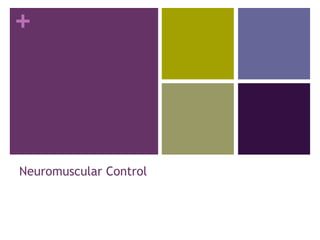Neuromuscular control
•Als PPTX, PDF herunterladen•
0 gefällt mir•1,668 views
Melden
Teilen
Melden
Teilen

Empfohlen
Weitere ähnliche Inhalte
Was ist angesagt?
Was ist angesagt? (20)
Introduction to Lumbar Spine Mobilisation - Maitland & Mulligan Techniques

Introduction to Lumbar Spine Mobilisation - Maitland & Mulligan Techniques
BIOMECHANICS AND PATHOMECHANICS OF SKELETAL MUSCLE

BIOMECHANICS AND PATHOMECHANICS OF SKELETAL MUSCLE
Ähnlich wie Neuromuscular control
Neuro anatomy and physiology of masticatory system/certified fixed orthodonti...

Neuro anatomy and physiology of masticatory system/certified fixed orthodonti...Indian dental academy
Neuro anatomy and physiology of masticatory system /certified fixed orthodont...

Neuro anatomy and physiology of masticatory system /certified fixed orthodont...Indian dental academy
Ähnlich wie Neuromuscular control (20)
Chapter 1 structure and function of the muscular, neuromuscular, cardiovasc...

Chapter 1 structure and function of the muscular, neuromuscular, cardiovasc...
Human nervous system for allied health students.ppt

Human nervous system for allied health students.ppt
Neuro anatomy and physiology of masticatory system/certified fixed orthodonti...

Neuro anatomy and physiology of masticatory system/certified fixed orthodonti...
Neuro anatomy and physiology of masticatory system /certified fixed orthodont...

Neuro anatomy and physiology of masticatory system /certified fixed orthodont...
Mehr von trieducation
Mehr von trieducation (20)
Neuromuscular control
- 2. + Key Concepts It is important to understand the microscopic structure of skeletal muscle and how these structures assist with creating movement. Muscles create movement by pulling on the bone to which they attach. In order to do this, messages are sent from the brain to the muscles to initiate movement. Muscles coordinate in pairs to produce coordinated movement
- 4. + A motor unit A motor unit consists of one motor neuron and the muscle fibre it stimulates (Each neuron may stimulate a number of muscle fibres) Depending on the size and function of a muscle will depend on the number of motor units it has Example: The quadriceps is responsible for gross movement such as kicking and jumping. It has a very large number of motor units The muscles that control movements like writing and typing have only a small number of motor units.
- 6. + The ‘all or nothing’ principle The nerve impulse will not stimulate the muscle fibres until it reaches a certain threshold level. Once the nerve impulse reaches this threshold, all fibres of the motor unit will contract at the same time and maximally. If the impulse is too weak, no fibres will contract. Therefore depending on the force required for a movement will impact the number and speed of nerve impulses sent.